Garlic: Diseases and Symptoms
Garlic: Diseases and Symptoms
- Damping off
- Purple blotch
- Stemphylium leaf blight
- Colletotrichum blight/anthracnose/twister disease
- Fusarium basal rot/basal rot
- White rot (Sclerotial rot)
- Black mould (Aspergillus sp)
- Bacterial soft rot
- Iris yellow spot disease
- Onion yellow dwarf disease
- Downy mildew
- Bacterial brown rot/Slippery skin
- IPM for Garlic
Damping off
Disease symptoms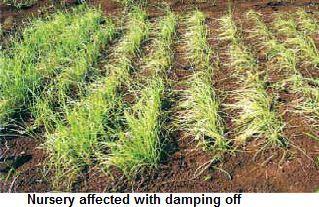 Two types of symptoms are observed-Pre-emergence damping-off : This results in seed and seedling rot before they emerge out of the soil.
Two types of symptoms are observed-Pre-emergence damping-off : This results in seed and seedling rot before they emerge out of the soil.- Post-emergence damping-off : The pathogen attacks the collar region of seedlings on the surface of soil. The collar portion rots and ultimately the seedlings collapse and die.
- Pathogen(s) survives on infected crop debris and soil which are source of primary inoculum.
- The disease is more prevalent during kharif season/rainy season and causes about 60-75% damage.
- High soil moisture and moderate temperature along with high humidity leads to the development of the disease.
Purple blotch
Disease symptoms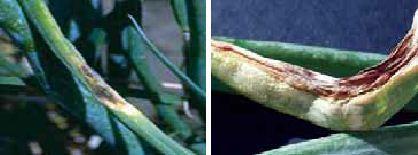 The symptoms occur on leaves and flower stalks as small, sunken, whitish flecks with purple coloured centres.
The symptoms occur on leaves and flower stalks as small, sunken, whitish flecks with purple coloured centres.- The lesions may girdle leaves/stalk and cause their drooping. The infected plants fail to develop bulbs
- The disease is soil borne and fungus survives in soil, infected bulbs and may persist in plant debris or on roots of weeds.
- Hot and humid climate with temperature ranging from 21-30° C and high relative humidity (80-90%) favour the development of the disease.
Stemphylium leaf blight
Disease symptoms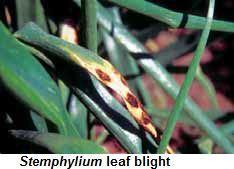 Infection occurs on radial leaves of transplanted seedlings at 3- 4 leaf stage during late March and early April.
Infection occurs on radial leaves of transplanted seedlings at 3- 4 leaf stage during late March and early April.- The symptoms appear as small yellowish to orange flecks or streaks in the middle of the leaves, which soon develop into elongated spindle shaped spots surrounded by pinkish margin.
- The disease on the inflorescence stalk causes severe damage to the seed crop.
- The fungus survives in plant debris or soil.
- Warm (18-25 °C) humid conditions and long periods of leaf wetness (16 hours or more) favour disease development.
Colletotrichum blight/anthracnose/twister disease
Disease symptoms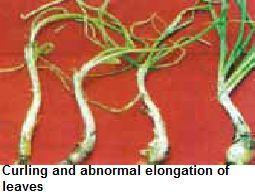 The symptoms appear initially on the leaves as water soaked pale yellow spots, which spread lengthwise covering entire leaf blade.
The symptoms appear initially on the leaves as water soaked pale yellow spots, which spread lengthwise covering entire leaf blade.- The affected leaves shrivel and droop down.
- The fungus can survive for many years as sclerotia in the soil or for shorter periods in infected plant debris.
- Disease is most severe in warm [25-30° C], moist soils that are high in organic matter.
- Fungal growth rapidly decreases below 15° C, resulting in little disease development.
Fusarium basal rot/basal rot
Disease symptoms Initially yellowing of leaves and stunted growth of plant is observed, which later on dry from tip to downwards.
Initially yellowing of leaves and stunted growth of plant is observed, which later on dry from tip to downwards.- In early stage of infection, the roots of the plants become pink in colour and rotting take place later. In advanced stage, the bulb starts decaying from lower ends and ultimately whole plant dies.
- Pathogen survives in soil and garlic bulb as a primary source of inoculum in the form of Chlamydospore, resting spore) for many years.
- Moist soil and 27° C temperature favours the development of disease.
White rot (Sclerotial rot)
Disease symptoms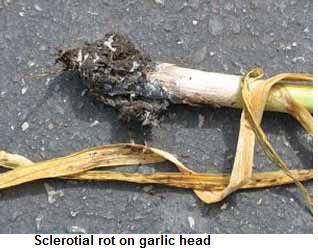 The initial symptoms are yellowing and dieback of leaf tips. Later, scales, stem plate and roots get destroyed.
The initial symptoms are yellowing and dieback of leaf tips. Later, scales, stem plate and roots get destroyed.- The bulbs become soft and water soaked.
- Later, white fluff y or cottony growth of mycelium with abundant black sclerotia resembling mustard grain develops on the infected bulbs.
- Fungus survives in soil as sclerotia for many years and it can over-winter in infected garlic debris and in diseased garlic sets.
- This disease is most severe in cool and dry soils.
Black mould (Aspergillus sp)
Disease symptoms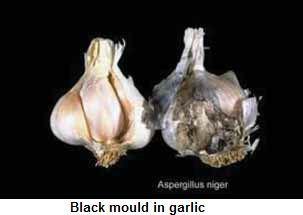 Infection usually is through neck tissues as foliage dies down at maturity.
Infection usually is through neck tissues as foliage dies down at maturity.- Infected bulbs are discolored black around the neck, and affected scales shrivel.
- Masses of powdery black spores develop as streaks along veins on and between outer dry scales.
- Infection may advance from the neck into the central fleshy scales.
- Fungus survives in air, soil and infected plant debris.
- Spores of this fungus are very common in the air and soil which are the source of infection.
- Black mold is most common when temperatures are higher than 30° C (86° F) in the field or 24° C in storage.
- Free moisture for six hours or longer on the garlic surface is necessary for infection to occur.
Bacterial soft rot
Disease symptoms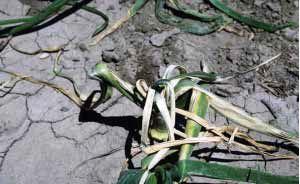 Bacterial soft rot is mainly a problem on mature bulbs. Affected scales first appear water-soaked and pale yellow to light brown.
Bacterial soft rot is mainly a problem on mature bulbs. Affected scales first appear water-soaked and pale yellow to light brown.- As the soft rot progresses, invaded fleshy scales become soft and sticky with the interior of the bulb breaking-down.
- A watery, foul-smelling thick liquid can be squeezed from the neck of diseased bulbs.
- The pathogen is soil borne and survives in infected plant debris as well as in soil.
- The bacterium is spread by splashing rain, irrigation water and insects.
- This disease is favored by warm, humid conditions with an optimum temperature range of 20-30° C.
- However, during storage or transit soft rot can develop when temperatures are above 3° C.
Iris yellow spot disease
Disease symptoms- Symptoms of iris yellow spot virus are often seen as a cream, elliptical spots on the leaves. The spots also appear on garlic scapes or flower stalks of garlics.
- As both infected leaves and scapes age, they can collapse at the site of the spots. The spots may be clear or less obvious. Although the spots may at first be insignificant, the disease has the potential of devastating the whole crop.
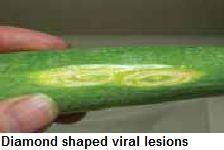 Onion thrips (Thrips tabaci) transmit IYSV in a persistent manner. Disease severity is positively correlated with thrips populations in the field.
Onion thrips (Thrips tabaci) transmit IYSV in a persistent manner. Disease severity is positively correlated with thrips populations in the field.- This virus is not seed transmitted. Over-wintering garlics, volunteers from prior productions, infected
- Transplants and alternate hosts can all serve as sources of both vector and virus.
Onion yellow dwarf disease
Disease symptoms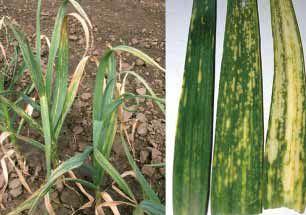 The first symptoms of onion yellow dwarf in young garlics are yellow streaks at the bases of the first true leaves.
The first symptoms of onion yellow dwarf in young garlics are yellow streaks at the bases of the first true leaves.- All leaves developing after these initial symptoms show symptoms ranging from yellow streaks to complete yellowing of leaves.
- Leaves are sometimes crinkled and flattened and tend to fall over. Bulbs are undersized.
- The virus is carried by infected seed bulbs, clove and volunteer garlic. Many aphid species can transmit this virus from infected to healthy plants.
Downy mildew
Disease symptoms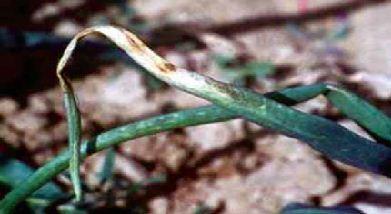 Leaves turn to pale green.
Leaves turn to pale green.- On leaves, cottony white mycelial growth develops and appears white. Gradually the leaves turn pale yellow to dark brown and dries up.
- Fungus survives in soil and infected plant debris.
- Warm and humid climate favours the development of disease.
Bacterial brown rot/Slippery skin
Disease symptoms- Field symptoms often appear as one or two wilted leaves in the center of the leaf cluster. These leaves eventually turn pale yellow and dieback from the tip while older and younger leaves maintain a healthy green appearance.
- During the early stages of this disease, the bulbs may appear healthy except for a softening of the neck tissue. In a longitudinal section, one or more inner scales become watery or cooked.
- The disease progresses from the top of the infected scale to the base
- Eventually, all the internal tissue will rot. Finally, the internal scales dry and the bulb shrivel.
- Squeezing the base of infected plants causes the rotted inner portion of the bulbs to slide out through the neck, hence the name slippery skin.
- This bacterium is soil-borne and can be readily water-splashed to the foliage and necks where it can enter through wounds.
- This bacterium requires moisture for infection and grows in the temperature range of 5-41° C.
- Heavy irrigation and persistent dews are also conducive to this disease.
IPM for Garlic
To know the IPM practices for Garlic, click here.
Source: NIPHM and Directorate of Plant Protection, Quarantine & Storage
Last Modified : 3/31/2020
© C–DAC.All content appearing on the vikaspedia portal is through collaborative effort of vikaspedia and its partners.We encourage you to use and share the content in a respectful and fair manner. Please leave all source links intact and adhere to applicable copyright and intellectual property guidelines and laws.
RELATED ITEMS
Cabbage and Cauliflower diseases
This topic covers information about Cabbage and Ca...
Fenugreek Diseases
This topic covers information about Fenugreek Dis...
Onion: Diseases and Symptoms
This topic covers the Information related to Disea...
Cucurbitaceous Vegetable Diseases
This topic covers information about Cucurbitaceous...
